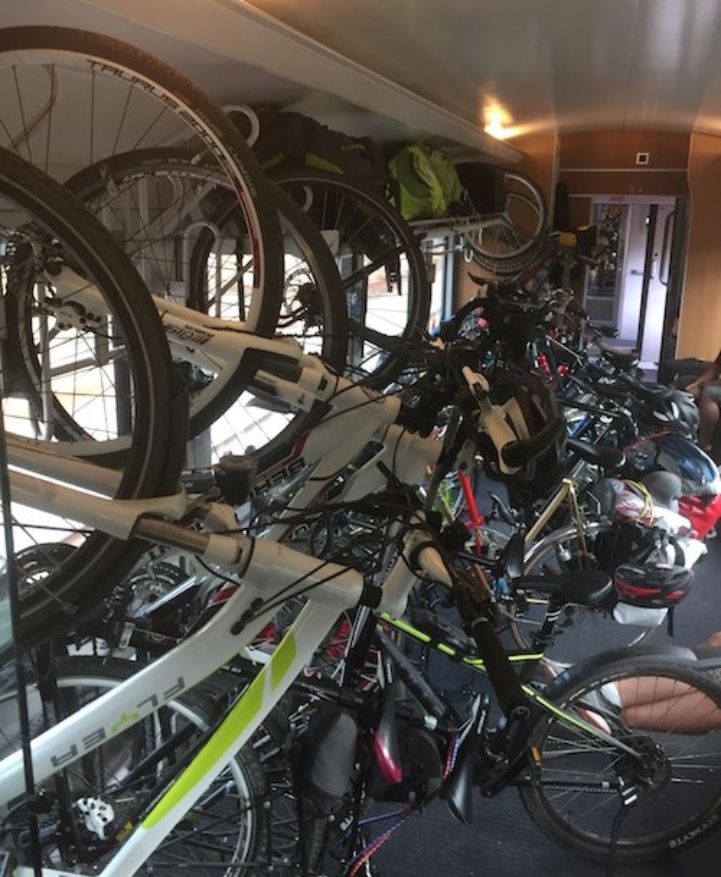Transporting bicycles on trains - Inter-modality mini-series 2/3
Many challenges for the combination of bicycles and trains
Do you live too far away from your cycling destination to start your cycling trip on the EuroVelo routes? Or do you want to plan your holiday so that you can only explore the most beautiful stages by bike? Perhaps parts of a cycle route are not currently passable due to heavy traffic or construction work. In these cases, jumping on a train can be a good option. Trains are a relatively fast, convenient, and well-connected mode of transport that, together with the bicycle, make a great combination for sustainable mobility.
As good as that may sound, unfortunately train travel with bicycles is often not that simple. Most regional and local trains accept bikes on board, but high-speed and long-distance trains still make transporting a bicycle difficult. The presence of multiple transport providers and companies generates variable rules and regulations regarding bike travel which in turn make it difficult for cyclists to plan their journey by train and bike.
This is often already evident even when you are just planning your trip: many booking portals of railway operators provide unclear information, limited language options or confusing ticketing and reservation policies. In addition, the railway stations and the trains themselves are often not equipped for a hassle-free transfer.
On the right track but still a long way to go

A significant step has been made recently towards a more bike-friendly future for trains in Europe. As a result of the European Cyclists’ Federation’s (ECF) 2020 Cyclists Love Trains campaign, new and refurbished rolling stock will need to include a minimum of four dedicated bicycle spaces per train from 2025 onwards.
However, there is a lot of progress still to be made. In the recently published report prepared by ECF, 69 railway companies and services across the continent have been ranked and analysed according to their bicycle friendliness, with the focus on long-distance trips. Of these 69 undertakings, 15 of them (22%) do not currently even accept non-foldable and un-dismantled bicycles. In contrast, the NS-DB joint venture, Intercity Berlin, which runs between Berlin and Amsterdam - ranks highest due to its flexibility for users. This is great news for those who wish to start their cycling adventure along EuroVelo 2 – Capitals Route or EuroVelo 7 – Sun Route from Berlin. Other train companies that scored well are Swiss Federal Railways (SBB), the National Railway Company of Belgium (SNCB/NMBS), Deutsche Bahn (DB) and Hungarian State Railways (MÁV-START).
It is worth highlighting the changes that are being made in France, which could be an example for others to follow. Next to the recent legislation for trains in France to provide a minimum of 8 bicycle spaces per train, many train lines decided to top up bike spaces for peak hours in summer. Indeed, along ‘La Loire à Vélo’ - among one of the country’s most frequented cycle routes (and part of EuroVelo 6 – Atlantic – Black Sea) – a dedicated rail service has been set up. Between June and September, spaces for at least 17 places for bicycles will be added to the 33 places normally available. EuroVelo 1 – Atlantic Coast Route (La Vélodyssée) users will also be happy to hear about the up to 25 additional bicycle spaces on line 41.2U between Bordeaux and Arcachon. Both examples have no need for reservation, no additional costs and even someone on the platforms to help get the bikes on and off! For more information about taking bicycles on the train in France, you can check out this link.
In Austria, the railway operator ÖBB has also been making efforts to become more bike-friendly. Several of the Nightjets - its night train service that links Austria with many surrounding countries such as Germany, Italy and Switzerland – are equipped with dedicated bicycle spaces.
Those who want an easy way to get on and off the train will be convinced by the recently introduced ScotRail Highland Explorer carriages between Glasgow and Oban. The carriage has been specially designed to make it easy for more people to use the service as the design requires you to lift the front of your cycle only a small amount off the ground and into the wheel restraint. Each carriage has a total of 20 individual bike racks and a reservation for a cycle space can be made on the phone, online, or in person. This train connection can be ideal for those starting or finishing their cycle journey on the EuroVelo 1 - Atlantic Coast Route in Glasgow.

However, there is much room for further improvement across Europe. The European Cyclists’ Federation (ECF) advises railway companies to bear in mind the following things when it comes to offering good quality conditions for bicycle carriage.
- Acceptance of non-foldable and un-dismantled bicycles on all train services.
- Dedicated bicycle spaces which are accessible and easy to use for all types of passengers.
- Keeping the costs of bicycle tickets as low as possible.
- The provision of clear and concise information on bicycle services, inclusive of the booking, embarkation, and disembarkation processes.
- A pan-European journey planner and coordination of bicycle carriage rules.
In 2021, with the European Green Deal, the climate crisis, and the COVID-19 recovery, high on the agenda the train has gained more importance. During this European Year of Rail, the bicycle must be considered as an important partner allowing trains and bicycles to grow together as a dream team for #MoreCyclingTourism!
Tips for a stress-free experience when transporting bicycles on trains
When including a train ride in your future EuroVelo cycling trip, planning is often essential. The following points are good to keep in mind before approaching a train station with your bicycle.
1. Plan ahead when possible! Most long-distance routes require a booking for a bicycle, often some time ahead and have only limited space. The Eurail and Interrail websites give some advice on travelling by bike in Europe.
2. Avoid rush hour, choose mid-morning or the afternoon to travel.
3. Look for the bicycle symbol on the train doors that mark the cycle storage area.
4. Talk to the other cyclists on the train using the storage area. Check that their bikes will not hinder you when disembarking. Detach the saddlebags from your bike for an easier arrangement.
5. Slip a strap into your saddlebags. If necessary (more space in the dedicated spaces, for example), this accessory will allow you to properly anchor your bike during the journey.
6. Enjoy the ride! Sit back, relax, watch the scenery and be happy that you have succeeded in taking a bicycle on the train.

Author: Antonia Tornow, with contributions from Charles Carnegie